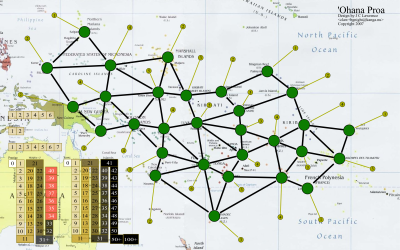Beat the drums lowly, the changes are slowing
New rules.
New player aid.
Slight edits to the map:

-
Added a red section to the prestige track to call out the game ending condition of 33 or more prestige
-
Removed the previous player aids on the map as they’ve been supplanted by the actual player aids
– Trimmed the size of the background image to be narrower as we had difficulty fitting the game on the narrow tables in this weekend’s sessions
As I’ve had difficulty finding a good map of the thousand islands region of the St Lawrence River, I’m going to toss the Earthsea map and just use the same base map for three players by just varying the setup:
-
Back down to 5 colours of markets instead of 6. This should change the rate of market stacking on development from 1/3 to 2/5 (ie slightly more frequent). The result will be a marginally more resource and thus prestige rich game, but also one in which delivery opportunities and intersections matter more.
-
One less market per development stack. This should accentuate the slight starvation patterns encouraged by the reduction in colours. It should also encourage a more diffuse network building pattern. Happily the math works out too.
Both changes should lead to a tighter, leaner and more aggressive game, as suited for 3 players.
There were several more playtests this weekend. All played smoothly and I’m well pleased. I’ll attempt to remember to get the pictures off my camera and post them. Calling out two sessions in particular:
Session 1:
4 players, 3 new, playtime of 165 minutes. Game ended on 33 prestige but would have continued no more than 2 more turns before one market ran out. All four players had more than 30 prestige. Less than a dozen points spanned from first to last, making this the closest game to date. The eliminated player had the second highest score before elimination.
The new player aid was frequently used in the rules teaching and was regularly referred to during the first quarter of play (up until just after focus moved from resources to kula). We started out with a 3 player game but then added a fourth (Eddie) just after the rules explanation. Jason did a notable job of teaching Eddie the rules while I ate lunch. While I gave him a copy of the rules, he taught the game entirely from and with frequent reference to the player aid. Jason called out the player aid as both useful both in comprehending the game and in adding a comfort level for players attempting to digest the game’s complexity (‘’I can ignore the details, concentrate on the big patterns, and look up the details on the player aid later when I need them’‘).~~
Session 2:
4 players, 2 new, playtime of 130 minutes. Game ended on 33 prestige but would have continued no more than another turn before one market ran out. Two players had more than 30 prestige. More than 30 points spanned from first to last. One of the players from the first session above beat me by 1.5 points – he had second-most VPs but just enough more prestige than me to take the win. The eliminated player had the lowest score before elimination and appeared overwhelmed for much of the game. Again the player aid was frequently referred to during rules teaching and up until shortly after the kula race started.
While players were (almost) always able to answer their questions from the player aid, there seemed to be some uncertainty on where to look on the player aid for the answer to a particular question. My current summary is that the player aid has the right factual content, but may need a presentation/sectioning/titling adjustment.~~